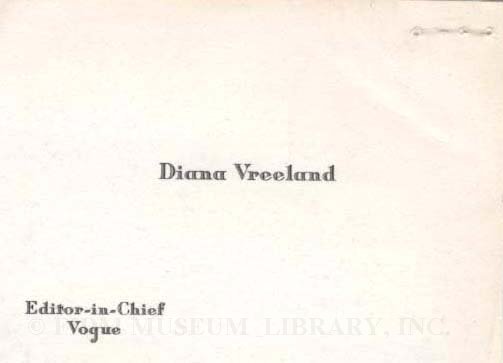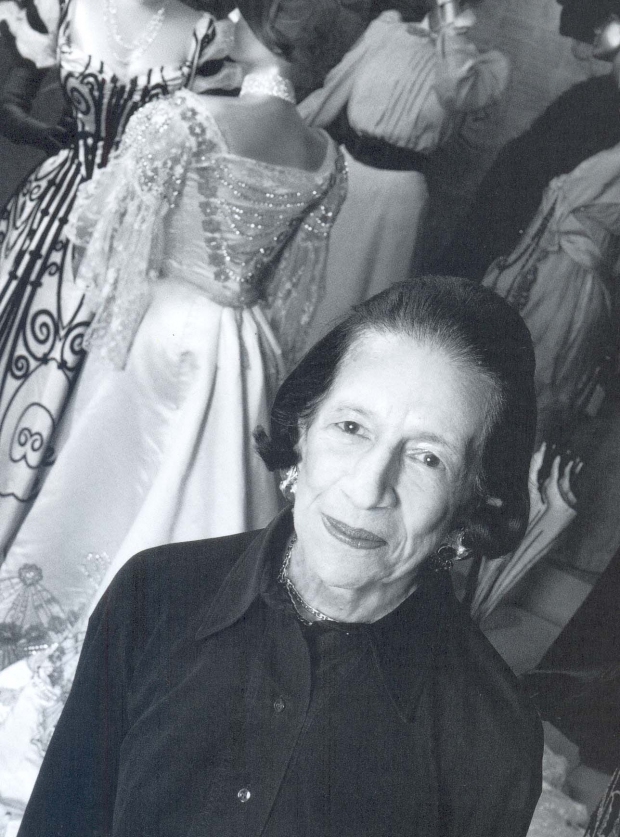Before fashion editors like André Leon Talley and Anna Wintour, there was the seminal Diana Vreeland. Celebrated for her impeccable style, larger than life persona, and impressive career, she influenced not only the fashion world, but the museum world as well. Here, FIDM Museum research intern and museum studies graduate student Danielle Clark-Perez shares Diana’s life story and investigates her influence on fashion studies and curating today.
 Diana Vreeland's calling card
Diana Vreeland's calling card
1963-1971
2003.40.99
Gift of Anonymous Donor
Diana (pronounced Dee-AHN-a) Dalziel was born on September 29, 1903 in Paris, France to an American mother and English father. From a young age, Diana exhibited a flair for all things sartorial and aesthetic–she was admired amongst her classmates for her carefully crafted outfits and once painted all of the electric light fixtures in her room black and her bedrooms walls a bright blue! While she was plagued by insecurity over her looks as a girl, by her late teens she had grown into a self-assured young woman with an exuberant personality–not to mention a dazzling social life. Diana was often seen at high society parties and took glamorous weekend vacations with friends. In 1923 she met the love of her life, Reed Vreeland. Diana was immediately smitten and they were married in 1924. She wore a medieval style white satin gown and carried Easter lilies.  Diana and Reed Vreeland, late 1920s. Image courtesy of the FIDM Museum Library.
Diana and Reed Vreeland, late 1920s. Image courtesy of the FIDM Museum Library.
In 1929, after her two sons were born, the Vreelands moved to London. It was here that Diana would become renowned for her innate sense of style and taste. In the 1930s she began frequenting European couture fashion houses and was even sketched in the November 1933 issue of Vogue wearing Mainbocher. She became friends with designers like Coco Chanel and Elsa Schiaparelli, and immersed herself in the London and Paris social scene.
In 1935 the Vreelands moved to New York City and Diana continued to garner attention. One year later Carmel Snow, editor-in-chief of Harper’s Bazaar, recognized Diana’s knack for ingenuity and creativity and hired her as a full-time fashion editor. Soon, her column “Why Don’t You?” in which she offered fashion advice and inspiration like “Remember that the smaller your head the more extreme shoulders you can wear on your coats” and “Why don’t you…turn your child into an Infanta for a fancy-dress party?” became a popular trademark of the magazine. Diana would eventually become responsible for all of the magazine’s fashion and photography. During her 26 year tenure, she heralded in a new sense of pride and appreciation for American designers. 
Harper's Bazaar cover, March 1959. Image via.
In January 1963 Diana brought her innovative perspective and talents to another fashion powerhouse publication: Vogue. Hired as associate editor, and then promoted to editor-in-chief, she was expected to encourage the publication’s dwindling sales and infuse its pages with a fresh sense of style and fashion. She did so in her own unique way–by sharing what she thought was beautiful. Never one to hide behind the desk of her scarlet-colored office, she worked with legendary photographers like Richard Avedon and Patrick Lichfield, trekked the globe for shoots in exotic locations like Morocco and Thailand, and loyally attended fashion shows from New York to Paris and beyond. However after ten years, Vogue’s publishers grew tired of her lavish spending and “youthquake” vision of the 1960s. She was fired, much to her surprise, in 1971.
 Vogue
Vogue
March 1, 1965
2011.5.4
FIDM Museum Special Collections
Without Reed who had passed away in 1966, and without her job, Diana found herself at a bit of a loss. The Metropolitan Museum of Art, whom like Diana was undergoing major changes, was looking to invigorate its recently expanded Costume Institute. Impressed by her dedicated work ethic and dramatic ideas, Met director Thomas Hoving hired Diana as a “special consultant” for the Costume Institute in 1972. Diana wanted to create sensational exhibits that would appeal to a contemporary audience, which often left her at odds with museum staffers and traditional museum methods. She insisted upon pumping perfumed air through the air conditioning system and using bright lights to illuminate old and fragile garments. Nonetheless, her exhibitions like “The World of Balenciaga” and “The Glory of Russian Costume” (12 in all) were highly successful and attracted record numbers of visitors. Her contributions aided in transforming the entire field of costume history and fashion curating.  Diana Vreeland with dressed mannequins at the Metropolitan Museum of Art's Costume Institute, 1970s. Image via.
Diana Vreeland with dressed mannequins at the Metropolitan Museum of Art's Costume Institute, 1970s. Image via.
Bibliography:
Clark, Judith and Amy de la Haye with Jeffrey Horseley. Exhibiting Fashion: Before and After 1971. Yale University Press. London. 2014.
Dwight, Eleanor. Diana Vreeland. HarperCollins Publishers. New York City. 2002.
Vreeland, Diana. D.V. Ecco. New York City. 2011.
Diana Vreeland: The Eye has to Travel. Dir: Bent-Jorgen Perlmutt, Lisa Immordino Vreeland, Frédéric Tcheng. Samuel Goldwyn Films. 2012.
For more on Diana Vreeland visit:
Diana Vreeland and Givenchy interview: http://www.youtube.com/watch?v=DPtEdovzZUY
Diana Vreeland: The Eye has to Travel trailer: http://www.youtube.com/watch?v=Rh8-6PRiyso

